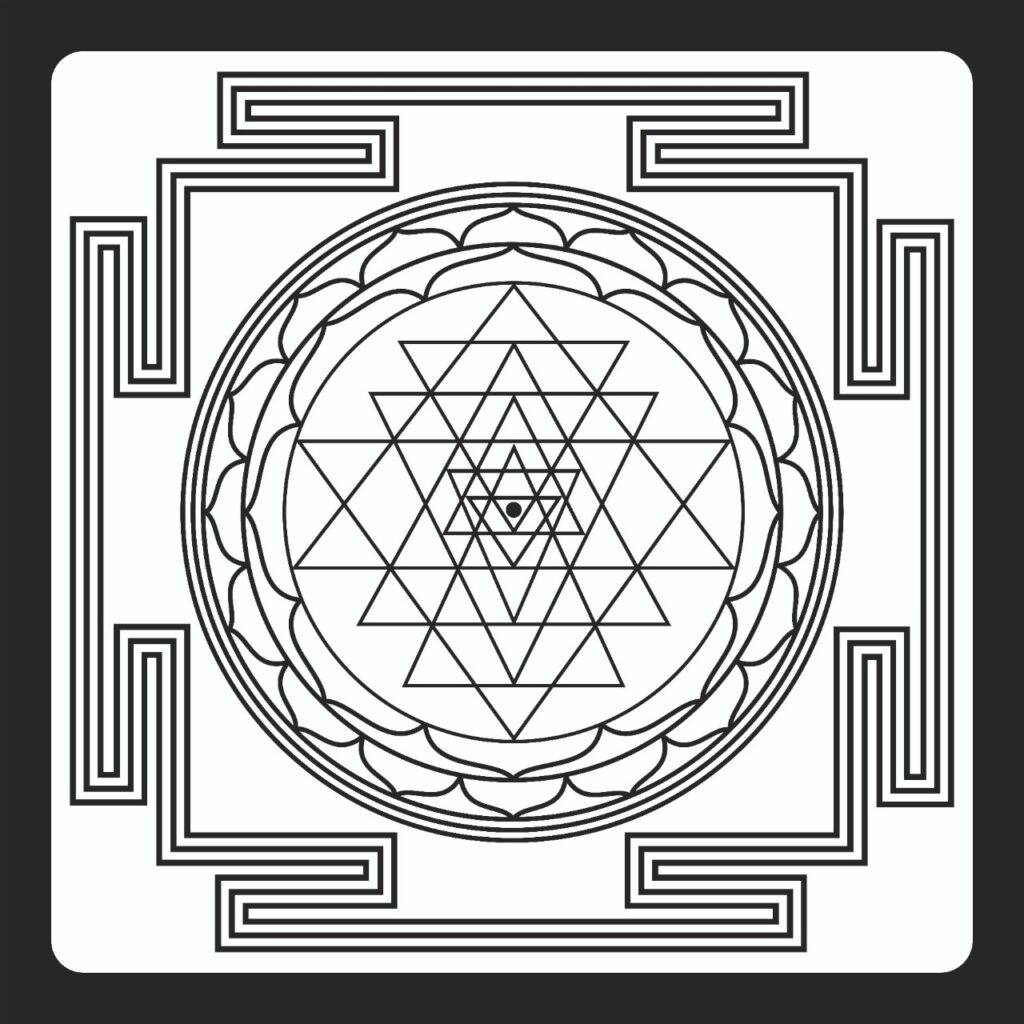Everything About Shree Yantra
About Shree Yantra
- The Worship of Shree Vidya has been Popular in India from very ancient times. Swami Gaurpad the teacher of Adi Shankaracharya was a worshipper of Shri Vidya.
- He initiated Shankara into the worship of Shri Vidya and Shankara wrote a very enlightening book on this subject. The worship of Shri Yantra has been very popular among Shaktas, Vedantacharyas, Vaishnavas, and Shaivas.
- The Third Mahavidya out of the ten, Known as Shodashi is Shri Vidya. She is known by various names – Sundari, Lalita, Tripursundari, Shodashi, and Bala.
- To Worship, Shri Vidya or Shri Yantra has to understand her yantra, which the most fascinating of all and known as Shri Yantra. Shri Chakra or Lalita Chakra.
- The Worship of Shree Yantra, the method of Constructing it, and its complete explanation are given in saundariya Lahiri. Shree Yantra is very eye-catching and powerful
- .It is constructed with an intersection of nine triangles. Four of these triangles are pointing upward and five downward. The four upward-pointing triangles are Shiva triangles and the five downward point triangles are Shakti triangles.
- A combination of these nine triangles makes Shri yantra the most dynamic of all yantras. For the purpose of Worship, a Shree yantra is engraved on copper, silver, and gold plates as a flat line drawing, or sculpted from stone and precious gems (quartz, Crystals, etc.).
- This form of Shri yantra looks like a pyramid, and there are many such yantras available from ancient times.
Nine Figures of Shri Yantra
Shree Yantra usually represents the body of the Goddess Tripursundari, although some scriptures refer to it as the naval of the divine mother.
A sculpted form of the divine mother is available in which the Shri Yantra is inscribed in the navel. Shree Yantra is also known as the the yantra of cosmos.
In Kamala Vilas, it is said that Shri yantra is constructed on the same principles on which the human organism is constructed.
Just as the body has nine chakras, so a Shri yantra has nine chakras as follow 1 Bindu (2) Trikon – the central triangle, which contains the Bindu (3) Ashtar – a group of eight triangles outside the trikon (4) Antar Dashar – A group of ten inner triangles (5) Bahir Dashar – A group of ten outer triangles (6) Chatur Dashar – A group of fourteen triangles (7) Ashta Dal – a ring of eight lotus petals (8) Shodash Dal – A ring of Sixteen lotus petals (9) Bhupur – the Square form with four gates
- The word Chakra in Shri yantra means a group, not the psychic centers of Kundalini Yoga, but there is a definite relationship between the nine figures of Shri Yantra and the nine psychic centers
- Shri Yantra is the cosmic form ( the diagram of evolution and development of the cosmos)
- the form of the human organism (the diagram of inner circuits of the body)
- the form of the goddess Tripur Sundari (because the goddess is energy, which pervades the entire phenomenal world)
- The five downward-pointing triangles i.e Shakti triangles manifested as five tanmatras (sound, touch, sight, taste, and smell) five mahabhutas (akasha, air, fire, water, and earth), five sense organs (ear, skin, eyes, tongue, and nose) in the human body these five elements are skin, nerves, flesh, fat, and bones.
- The four upward-pointing triangles, which are shiva triangles, represent the male energy and exist as Chitta, buddhi, ahamkara (self-consciousness or feeling of I), and manas (mind).

Bindu
- Bindu, the point inside the central triangle and the center of the yantra, is also known as Sarva Anandmayi Chakra, which means a Chakra of total bliss. and the seed of the entire universe, and it is beyond time and space.
- In this Bindu, Kameshwar (Lord of Kama or desire) and Kameswari (the Shakti of the desire for final union) remain ever united. Kameshwar and kameshwari are in human organisms above the som chakra in Sahasrar chakra.
- During meditation on the Shri Yantra, worship of Shiva and Shakti in an eternal union is done by concentrating on the Bindu. The worship of Ishtha Devata and Guru is also done by focussing on Bindu.
- Bindu is the last point in the yantra, but it is the center of the yantra, it is the beginning. Without knowing this point, the construction of a yantra is impossible.
- This makes the Bindu the prime cause, the seed of the yantra. The act of worship of Shri Yantra finishes with the meditation of the Bindu. Trikon Also known as Sarva Siddhi Prad Chakra, the trikon is the main triangle, in which the Bindu is located.
- It is the seed of the tree of creation and remains inside it in its subtle form. The three sides of the trikon are created by three goddesses – Kameshwari, Brijeshwari, and Agamalinin who are accompanied by three gunas (sattva, rajas, and tamas).
Ashtar
- Ashtar, the group of eight triangles is also known as Sarva Rog Har Chakra, a chakra that destroys all disease. The eight triangles are in fact eight yonis, which create the octave of existence. These eight triangles represent the eight goddesses, (1) Vashini (2) Kameshwari (3) Modini (4) Vimala (5) Aruna (6) Jayaini (7) Sarveshwari (8) Kaulini.
- The Ashtar is supposed to be the real Shri yantra. The eight triangles of Ashtar and one trikon-these nine are called the Navdwar chakra, which is the foundation of the phenomenal world.
- The worship of the Ashtar, trikon, and Bindu gives protection, power, and bliss and takes away all kinds of spiritual, mental, and physical ailments.
Antardashar
- Antardashar the group of ten triangles that surround the Ashtar is also known as the sarv rakshakar chakra – a chakra that provides all kinds of protection.
- In this chakra lies the power to protect because Protection is achieved not from outer but from inner disciplines.
- In this chakra lies the power to protect because this chakra is the control room of all the five organs of action and five organs of sense.
-
Bahirdashar
- Bahirdashar, the group of ten outer triangles that surround the Antar Dasher is also known as Sarva Arth Sadhak Chakra- a Chakra that makes all kinds of realization possible.
- This chakra gives one the power to realize what one wants, whatever gives meaning to one’s life. In the ten triangles are ten yonis or Shaktis. (1) Sarva Sampada Prada (2) Sarva Priyankari (3) Sarva Mangal Karini (4) Sarva Kam Prada (5) Sarva Dukha Swavimochini (6) Sarva Mrityu Prashamni (7) Sarva Vighna Nivarni (8) Sarvang Sundari (9) Sarva Saubhagyadayini (10) Sarva Siddhi Prada.
- Meditation on this chakra helps one get control over prana and control over prana gives control over the mind. Chaturdashi Chaturdashar, a group of fourteen outermost triangles or yonis, known as Sarva saubhagya Dayak chakra.
- Fourteen Shaktis residing in the Yonis and these goddesses control the fourteen nadis (1) Mind (2) Buddhi (3) Chitta (4) Ahamkara and ten indriyas.
- This way these goddesses constitute an outside form of the yantra and the body. This is evident by the name Sarva Saubhagya Dayak chakra-a chakra that gives all good fortune.
ASHTADAL
Ashtadal, the ring of eight lotus petals, is also known as Sarva Sankshoban Chakra. These petals are the seat of eight goddesses and eight petals symbolize (1) form (rupa (2) Rasa (taste (3) Smell (gandha) (4) Touch (Sparsh) (5) Sound (shabda (6) Nada (primordial sound) (7) Prakriti (8) Purusha (the self).
Shodashdal
Shodashal, the ring of sixteen lotus petals is also known as Sarva Ashapurk Chakra, the chakra of fulfilling all hopes, of materializing all kinds of expectations.
These Shaktis work through five elements, ten indriyas, and one mind sixteen tools.
Bhupur
Bhupur, the square with four gates, is also known as Traiyelok Mohan Chakra, the Chakra that attracts the three lokas (planes).
Physical (bhuloka), Astral (Bhuvarloka), and celestial (swargloka). Usually, Bhupur is the seat of the yantra – the dwelling place of the Shakti, representing the gross material phenomenon, in which she dwells as long as the cycle of creation and preservation lasts.
All guardians of the eight directions (dikpalas) are present in this bhupur. Ten Siddhis and eight mothers are present in this bhupur. This Chakra is a meeting place of the three currents Ganga, Yamuna, and Saraswati, this symbolically means the meeting place of the gross and subtle energies.
Benefits of Shree Yantra
Shree Yantra signifies the Goddess of wealth Laxmi. Helps removing financial and mental problems brings stability and success in the devotee’s life.
Shree yantra is the generator of supreme energy, is nothing but it is another form of element in the shape of waves and rays. It has a very high and great magnetic power. These converted to the surroundings where it is destroying all destructive forces within the atmosphere.
Yantra credited with divine hidden energies that can publish within a short measure. Shree Yantra is a holy instrument that has a mythological connection with Goddess Lakshmi, the Hindu deity of fortune, prosperity, benefits, and wealth.
Hindu religion hailed for its age-old Vedic culture and traditions. It has drawn the curiosity of many philosophers and scientists from across the world. Shree Yantra is a Sanskrit word, which means any object or a geometric diagram used in worship as a meditation aid.
Mantra
II Om Shrim Hrim Shrim Kamle Kamlalaye Praseed Praseed Om Shrim Hrim Shrim Mahalaxmayai Namah II
Definition of Geometrical Diagram of Shree Yantra
- Shri Yantra also known as Shri Chakra “Holy Ring” and consists of a central point, which a presentation of the connection point between the physical universe and its complete source.
- Nine interlocking triangles surround this central point. All the nine triangles interlocked in such a way that it makes a total of 43 smaller triangles, surrounded with a Circle of eight Lotus petals with an Outer Ring of Sixteen Lotus Petals, and the outer side of it three lines interspersed in four equal entrances.
- In a structure symbolizing a womb or entire cosmos.
Chakras Details.
- Trailokya Mohana Chakra for the outer square, Drawn in three lines and interspersed in four equal entrances.
- Sarvsha Paripurak Chakra for 16 Lotus Petals in Second Circle.
- Sarv Sankshobhini Chakra for 8 Lotus Petals in the Third Circle.
- Sarv Saubhagya Dayak Chakra for Outer group of 14 Triangles.
- Sarvartha Sadhak Chakra for the Next inner group of 10 Triangles.
- Sarv Rakshakar Chakra for Inner Small group of 10 triangles.
- Sarva Rogahar Chakra for Inner 8 small triangles.
- Sarv Siddhiprada Chakra for Inner single triangle
- Sarva Anandamayi Chakra for In Center The Yoni Bindu.
It considered very auspicious and pious to establish Sri Yantra at home or workplace and is a unique source of positive and spiritual energy with no other parallel.
Generally, as such, Shree Yantra worshipped in the morning by placing it on a yellow cloth. The Yantra placed over the Swastika symbol drawn with vermillion, so the whole practice regarding the Yantra can confirm by a religious guru having Vedic knowledge or a Hindu priest.
Like to explore different types of Sri Yantra, click here.
RudraPuja is a well-known Maker of exclusive Hindu Yantra. The company is a subsidiary of Virat Inc., a distinguished distributor of Hindu Yantra, Rudrakshas, Crystal Shree Yantra, Parad(Mercury), Japa Malas, Rudraksha Beads, Rudraksha Mala, and many other religious items. The company has established itself among the topmost Rudraksha Beads Suppliers In India. For more details regarding the products, offers you can log on to Rudrapuja.


